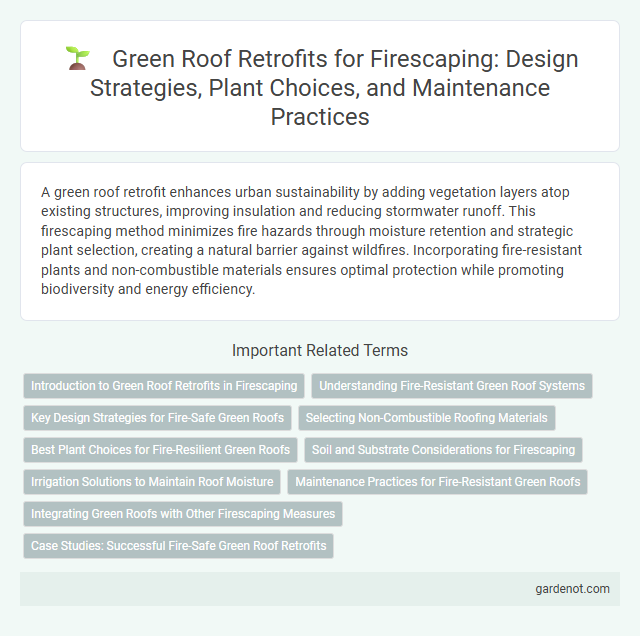A green roof retrofit enhances urban sustainability by adding vegetation layers atop existing structures, improving insulation and reducing stormwater runoff. This firescaping method minimizes fire hazards through moisture retention and strategic plant selection, creating a natural barrier against wildfires. Incorporating fire-resistant plants and non-combustible materials ensures optimal protection while promoting biodiversity and energy efficiency.
Introduction to Green Roof Retrofits in Firescaping
Green roof retrofits in firescaping enhance urban resilience by integrating fire-resistant vegetation and materials that reduce heat and slow wildfire spread. These systems improve building insulation and create defensible spaces while promoting biodiversity and stormwater management. Selecting native, drought-tolerant plants and non-combustible substrates is crucial to maximizing fire safety and environmental benefits.
Understanding Fire-Resistant Green Roof Systems
Fire-resistant green roof systems incorporate fire-retardant materials such as non-combustible substrates, irrigated vegetation, and moisture-retaining soil layers to minimize ignition risks. These retrofits enhance building resilience by creating a barrier that reduces heat transfer and prevents flame spread during wildfires. Selecting fire-resistant plant species and integrating advanced irrigation technology significantly improves the green roof's overall fire performance and sustainability.
Key Design Strategies for Fire-Safe Green Roofs
Key design strategies for fire-safe green roof retrofits include selecting fire-resistant, drought-tolerant plant species such as sedums and succulents to minimize flammable biomass. Incorporating non-combustible materials like gravel or stone borders and ensuring adequate spacing between vegetation clusters reduce fire spread risks. Installing irrigation systems and maintaining clear access pathways further enhance the green roof's resilience to wildfires and ember attacks.
Selecting Non-Combustible Roofing Materials
Selecting non-combustible roofing materials is essential for green roof retrofits to enhance fire resistance and mitigate wildfire risks. Materials such as metal, concrete, and specialized fire-resistant membranes offer durability and comply with fire safety standards while supporting vegetation growth. Incorporating these materials ensures the green roof maintains ecological benefits without compromising the structure's fire resilience.
Best Plant Choices for Fire-Resilient Green Roofs
Succulent species such as Sedum and Sempervivum are top choices for fire-resilient green roofs due to their high moisture content and low flammability. Native, drought-tolerant grasses and wildflowers with minimal resin content also reduce fire risk while supporting biodiversity. Integrating fire-resistant plants with deep root systems helps maintain soil stability and enhances the overall fire resilience of green roof retrofits.
Soil and Substrate Considerations for Firescaping
Soil and substrate selection is critical in green roof retrofit for firescaping, with fire-resistant, well-draining media preferred to reduce fuel availability and support fire-resilient vegetation. Lightweight substrates with high mineral content improve moisture retention while minimizing combustible organic matter, enhancing fire resistance on rooftops. Proper soil depth must balance plant health and fire mitigation, ensuring sufficient growth medium without increasing fire risk.
Irrigation Solutions to Maintain Roof Moisture
Green roof retrofits with effective irrigation solutions are essential to maintain optimal roof moisture and enhance fire resistance in firescaping. Drip irrigation systems and automated moisture sensors ensure consistent watering, promoting healthy vegetation growth while minimizing water waste. Integrating smart irrigation technology reduces fire risk by sustaining moisture levels critical to green roof resilience during dry conditions.
Maintenance Practices for Fire-Resistant Green Roofs
Regular inspection and removal of dead or dry vegetation reduce fire hazards on green roof retrofits. Adequate irrigation supports moisture retention in plant layers, enhancing fire resistance. Using fire-resistant plant species and maintaining clear drainage systems further minimizes fire risk while promoting healthy green roof performance.
Integrating Green Roofs with Other Firescaping Measures
Integrating green roofs with other firescaping measures enhances fire resilience by combining vegetation that retains moisture with non-combustible barriers and strategic landscape design. Green roofs act as a natural fire retardant by reducing surface temperatures and slowing fire spread, especially when paired with fire-resistant plants and regular maintenance. Combining these elements optimizes building protection and supports sustainable urban fire management strategies.
Case Studies: Successful Fire-Safe Green Roof Retrofits
Case studies of successful fire-safe green roof retrofits demonstrate innovative use of fire-resistant plant species such as sedums and native grasses, which minimize ignition risk while promoting sustainability. Projects in wildfire-prone regions like California and Australia showcase the integration of non-combustible growing media and strategic irrigation systems that enhance fire resilience. These retrofits balance urban heat island mitigation with robust fire protection, setting benchmarks for future green infrastructure upgrades.
Green roof retrofit Infographic

 gardenot.com
gardenot.com